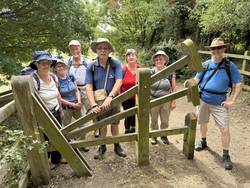A Matter of Stile!
Our July walk took us through surprisingly hilly countryside between the Cambridgeshire villages of Linton, Horseheath and Bartlow. We encountered historic features including a section of Roman road, huge burial mounds, medieval wall paintings, and a rare historic stile!
I don’t know that stiles are exclusively British, but they are a feature we see on virtually every walk. The origin of the word is the Old English, stigel, meaning a ladder or to climb, however not all stiles require you to mount them. Our walk on the Herriot Way a few years back was notable for the stone squeeze stiles in every field, each with a heavily sprung gate to smack you on the bum (or worse).
There are also the more common step stiles, usually a wobbly plank precariously balanced on a couple of logs, and their big cousins, the ladder stile. The third type of stile is the sort with moving parts: a prime example of which we encountered on our recent walk from Linton in Cambridgeshire.
A clapper stile, or tumble stile, was supposed to be easier for ladies in long skirts to negotiate. The Linton Clapper Stile is actually a grade II listed monument - "Three wooden planks pivoted on a central post and weighted at one end to return the planks to a closed position after they have been held down at the unweighted end for someone to pass through." The 200-year-old original has been replaced with a modern replica.
These days it seems that stiles are going completely out of fashion in the name of accessibility – something that any of us with shorter legs can sympathise with.
Lost to the Flames
In 1847 there was a terrible fire at Easton Lodge in Essex. Almost the whole of the Elizabethan part of the mansion was destroyed along with some of the most remarkable Roman artefacts ever discovered in the area. Our recent walk from Linton took us to where those objects had been found at Bartlow.
The Bartlow Hills are four (originally seven) Romano-British burial mounds, the biggest of which is around 15m high and is the largest barrow north of the Alps. They were excavated between 1832 and 1840 and the finds held in Lord Maynard’s possession at Easton Lodge. The lost items included several glass and bronze vessels and a rare metal folding stool as well as various pottery items. One thing that did survive was a unique enamelled bronze cauldron, which was too good to be left in rural Essex so was bought by the British Museum. A copy can be seen in Saffron Walden Museum along with a few other surviving objects. Why Essex? Well, Bartlow might be in Cambridgeshire now, but up to the 1880s it was part of Ashdon parish, Essex.
The west wing of Easton Lodge survived the 1847 fire, and the rest was rebuilt in less flammable Victorian Gothic brick. However, disaster was to strike again in 1918. The house was now owned by Lord Maynard’s granddaughter, Daisy, Countess of Warwick. The story goes that one of Daisy’s pet monkeys fell ill and was wrapped in a blanket and sat on the stove for extra warmth. The blanket caught fire and the monkey panicked, running around the room with the burning blanket in its wake, igniting the curtains and upholstery. The house was completely gutted, but apparently no one died, not even the monkey.
If you’re interested in the local history, more info can be found at Easton Lodge Gardens, Ashdon Museum, Great Dunmow Museum and Saffron Walden Museum.
Ali

